I am a planner. Or at least I want to be more of a better planner than I already am. One of my biggest struggles is finding time to sit down and make a plan of what I have to do and how I am going to get it done. I struggle with consistency in my planning. More so recently than ever before, my planner has just become a giant never ending to do list. I’m not saying there’s anything wrong with that, since planners are meant to keep you on track of what you have to do. However, my to do lists have been getting lazier and lazier. So, I am going to share some tips I have stumbled across to help you make your planner yours again and have it outline everything that is going on in your craziness that you are calling life.
I have created the following list of more than 50 tips to follow to ensure your planner is full of everything it needs to be filled with you and you are crushing every day that you wake up being ready for. One of the most important things to remember is to not beat yourself up over or put yourself down because you weren’t able to do everything on your list. I know that some days will be harder than others and some days we won’t get anything done and other days we might get more than what we intended to get done.
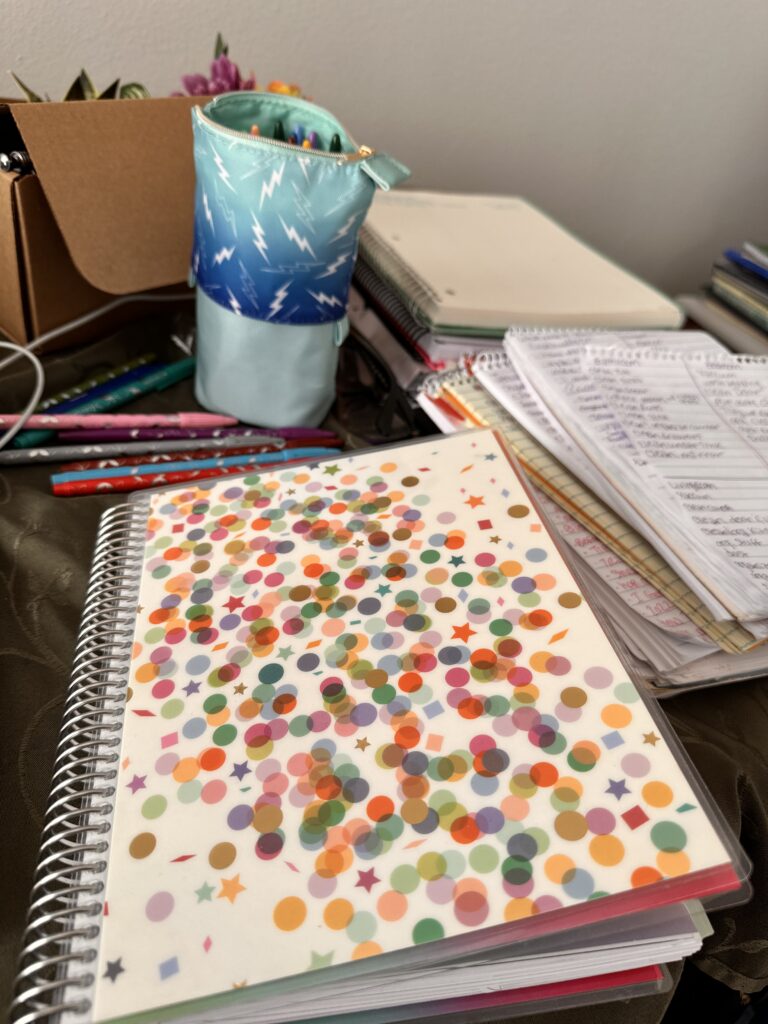
- Devote Time To Planning Everyday
If you live a very busy life and a life where you always have something going on or you have a million people’s schedules to keep track of besides just yours, taking a few moments every day to look at the overall picture is very vital. Planning every day helps you to ensure you aren’t overlooking anything. Making sure you have the right time and place of appointments, meetings, interviews, sport games, date night, or even girls brunch. Taking time to plan every day helps to be able to add everything that comes up and ensures you don’t double book something like shopping with the girls at the same time as your son’s baseball game or lunch with your significant other on the same day you’re getting a cavity filled. Planning every day can help avoid these mistakes and also help make you less overwhelmed when you suddenly have 5 to-do lists and 20 events to add to your planner. Making planning a part of a daily routine will help you keep on top of your daily routines.
- Make A List Of Larger Projects That You Need To Break Down Into More Manageable Tasks/Lists
At least once a week or month, depending on how often you have bigger projects, make a list and identify your bigger projects you’re working on, new ones, ones you’re still working on, and ones you might almost be done with. Keeping track of all the projects you’re working on can help prevent you from biting off more than you can chew. It can also help make you feel better about yourself knowing how much progress you’ve made since the day prior or the week prior. Sometimes we get big projects, I know. Whether it’s a work project, a personal project, or just simply you have yourself the project of cleaning your house, anything can really become a project. It’s important to make a game plan. Identify the project. Identify the steps and categories within this project. Identify how you want to execute each step. Breaking down something big into smaller steps can help you feel more accomplished because you are getting things done. It can also help you not feel so overwhelmed by having 3 big projects on your plate. I know sometimes that can lead to it not getting done or some massive procrastination. For example, if you have a project of cleaning your house. Break it down by room. Then break it down even further to identify what you need to do in each room in order for it to be cleaned. For example, when cleaning the house you will have rooms such as the bathroom, bedroom, kitchen, living room, etc. Let’s take the kitchen for example. You might break that down further and say you need to wash the windows, clean the oven, sweep and mop the floor, take out the trash, do the dishes, clean the table, etc etc.
Breaking down larger projects into smaller tasks can help us feel accomplished but it can also help us stay on track and ensure we are completing the project the way it needs to be.
- Identify Problems In Your Day Early
As soon as a problem arises in your day, note it. Make a note of what came up and how it might affect the rest of your day. What might you not be able to do now that this occurred. For example, you know you’re getting stuck late at work but you had dinner with friends planned, make sure to tell them as soon as you know as to not bail last minute and to avoid any hurt feelings. Or if a problem arises in a project you’re working on, make sure to make note of it and see if you are still going to be able to meet your deadline or not. Anything that could affect a deadline should be noted and brought to someone’s attention immediately and you should alter your day to accommodate it. Any sort of problem that arises could affect your day in numerous ways and it should be identified as early as possible. The earlier you identify it, the earlier you can re-plan the rest of your day to ensure things are still getting done.

- Use Time Blocks
I love time blocks. I love setting up my day in time intervals. I think it’s a great way to not overstimulate your mind by forcing it to focus on one task for way too long. You can use a time block in whatever intervals you want. Anywhere from 10 minutes to 2 hours. Depending on what works for you and what you need to ensure you accomplish that day. I typically use time blocks of 30 minutes to an hour. Time blocks allow me to plan out my day and give me an idea of what it might look like, and if I finish a task early enough, I can either finish earlier in the day or allow a small break between tasks. Depending on if I am working on not during the day will change how my time blocking might look. I also tend to give myself a little more time then I might need to complete a task to allow myself to have extra time at the end of the day to work on a side project. I might set aside my 8 hours for work. Then 30 mins to unwind from work. Then 30 mins for cleaning or go even more specific and identify tasks such as dishes and vacuuming or laundry. I then might give myself an hour for dinner and a shower. The rest of it will depend on what I’m working on or what needs to be done. However, using time blocks can help you look at your day and try to have a much more visual plan for what the rest of your day might look like and help you more or less stay on schedule and stay focused on your tasks. Instead of procrastinating and not starting your todo list until an hour or two before you’re supposed to go to bed.
- Be Realistic
When looking at your day, it is always important to remember to be realistic with the goals and plans you are creating for yourself. It is okay to have dreams and an ideal plan for how you would like the day to go. It is also okay to plan your day in such a way. However, after you do so, take another look at your day and look at what is realistically possible to be done that day. Maybe you want to wake up at 4 am to complete a work out and work on a side project, but you were volunteering at your son’s cub scout meeting and it ran late and one thing led to another and it ended up being after midnight by the time your head hit the pillow. Maybe 4 am isn’t as realistic as you would have liked it to be. Or maybe you want to accomplish 7 tasks off of your side project at home after work, but then you remember you have a meeting and you have to stay late at work. Being realistic with your planning allows you to not over plan and ensure you are not stretching yourself way too thin, and still getting done the most important things.
- Allow For Unforeseen Challenges - What Will You Do If XYZ Occurs
It is always important to leave room in your schedule just in case any number of unforeseen events occur. For example, leaving extra room in your schedule and allowing yourself to be flexible allows you to stay on track and not feel like you fell behind just because a meeting ran late or someone canceled and you were unable to finish your entire group project. Another way to look at this is, always have a backup plan. Plan out your day, realize where a challenge or problem could occur and replan the rest of your day from that point on if an error were to occur. Having a plan and a back up plan is a great way to ensure you never fall behind. A challenge may pop up but that’s still okay. You were able to get something done that you weren’t going to do until tomorrow. However, your big presentation you were going to have completed by the end of the day won’t be done until tomorrow or even the end of the week. If these sorts of situations tend to stress you out, there is another way to plan ahead. Give yourself a deadline for the project, whether it be a deadline for a project you are working on for yourself that may not have had a deadline otherwise, or a deadline about a week before the actual deadline of a project. This gives you plenty of time to work around challenges and to fix or change anything that may have occurred along the way.
- Prioritize Tasks
Before writing in your planner, grab a piece of scrap paper, or pull up a blank note in your phone, and write out everything you need to and want to accomplish today, tomorrow, this week, and/or this month. Once you have your list, identify the deadlines and prioritize. You can prioritize it by due date, by how long it is going to take you to do it, how much you might dread doing it, or any other way you might want to prioritize things. I suggest always taking into consideration their due date and the level of importance it holds when prioritizing tasks. Ensure you are putting your priority tasks at the top of your to-do list and ensuring it is planned into the next couple of days and save the end of the week or even next week for tasks that aren’t as important and don’t need to get done sooner rather than later.
- Multitask When Appropriate
It’s okay to multitask. However, it is important to know when it is appropriate and when it will lead to biting off more than you can chew. Multitasking can help you get more done in a shorter period of time. However, if it is done at the wrong time, it can lead to incomplete projects and tasks that are not done to their fullest potential or a lot of revision needs to be made and you need to completely redo one or all of the tasks. You have to know what tasks can easily be grouped together and what tasks are okay multitasking with. For example, doing the laundry is an easy task to be paired with something since the laundry does not take your fullest attention and you have a bit of waiting in between putting it into the wash and putting it in the dryer until it is completely done. On the other hand, tasks such as important work projects or time sensitive home projects might not be the best to use for multitasking as they take a lot more of your focus and have multiple steps to follow to ensure completion.

- Tackle Most Dreaded Task(s) First
Tackling your most dreaded tasks first is a great way to make sure you get them done. No matter how big or small, I know we all have tasks that we dread and that we hate having to do. However, getting them done first allows us to get them out of the way and ensures that we actually stick to our plan and we get these tasks done. Instead of pushing them off and saving them for last because then we will find every excuse not to do them. “I ran out of time” “It was way too late by the time I could have even started them” “I got really tired from doing everything else”, “No one was around to help at that hour”, etc etc. I know I always have tasks I dread doing and I have made the mistake way too many times of pushing off the tasks and allowing it to continue to sit on my to do list for over a week because I refused to prioritize it over easier, slightly more enjoyable tasks. Getting the dreaded tasks out of the way can be a great way to lead to a more productive rest of the day.
- Start Day Before Everyone Else Gets Up
Sometimes waking up before everyone else typically wakes up is a great way to start your day off the productive way. No one is awake at home to distract you or need something. No one at work or your social life is awake to try to communicate with you or ask you a question about something. I’m not saying this is for everyone… because let’s be honest…. I am so not a morning person and the thought or waking up earlier to get things done seems like absolute torture to me. However, it does work for people for it could be worth a shot. A major benefit to this is you also get to start your day earlier and getting things done before work can ensure you get them done since I know way too often you get home from work and you’re tired or you had a really crappy day at work and you don’t want to do anything else and the thought of any additional stress makes you want to scream. This is where waking up earlier comes in handy. You can also get in so much more in your day. For example, you can get in the workout you never had time for, you can actually enjoy a nice breakfast instead of waking up and rushing out the door a minute later, you have time to work on your business or your blog or growing your social media or any other sort of side project. There is so much more you can now do with your day by adding a few extra hours in the morning and getting a jump start and starting your productivity hours a few hours earlier.
- Schedule Pockets Of Calm In Your Day
With every busy day you have packed full of everything you need to ensure you schedule a little bit of calm within the chaos. Look at your day(s) ahead and see if you can move things around or shorten the amount of time you spend doing something (of maybe lesser importance) in order to schedule yourself some time to take a breather. Schedule something that is more relaxing. For example, schedule 10 minutes for meditation or schedule a small yoga session into your day.
- Leave A Margin In Every Day
You should always leave a margin in your day. Leave a few time slots in your day open just in case things fall behind schedule or you end up with tasks that end up taking a lot longer than you originally planned. Leaving a margin in your day can help ensure you can still get to everything you need to get to for the day and you stay on top of your to do’s.
- Know When To Delegate
Some days or weeks we simply have too much on our plates. It is important to realize when you’re biting off more than you chew. You should know when to delegate a task to a family member or roommate or spouse. Know when to ask for help and see if someone else can pick up your chores. Know when to delegate a task at work for a project you’re working on with a coworker to them instead of you if you have way too much going on. Or even know when to delegate a task to your future self because it just might not be feasible to get done today or this week.

- Re-Examine/Evaluate Regularly
The only thing better than planning your day is making sure you re-examine and evaluate your day or week regularly. This is important to make sure you always have every event and meeting that comes up in your planner to avoid double booking. This is also beneficial to help you move around your day if you need to if something comes up. You can also add/remove tasks to help make your day easier or fill it with another task in case something falls through and you now have an opening. For example, if a meeting gets canceled and now you have an unforeseen 2 hours open, you can move some of your tasks from later in the week up to today to help give you a lighter load later on just to leave room for other things that could pop up. It is always important to re-examine just so you never miss anything and you are always on top of planning and replanning when necessary.
- Find A System That Works For You
Everyone has a different system that works for them. Some people like color coding. Some people like to plan all at once. Some people like bullet points. Some people like time blocks. Some people like to add their work day and some don’t. Some people only use lists and others like adding everything. Some people like writing a day off and others do it a week in advance. Whatever works for you and works for your life and your planning needs, that’s the route you got to take. Don’t follow what others do if it doesn’t work. If writing everything out for you works…. Do it. If using notes and stickers and 5 planners and 3 notebooks is what helps and works for you… do it. Do what makes it easiest for you and don’t give yourself more work just because someone else plans like that.
- Accept Limitations
When looking at your day and planning you have to accept limitations. Accept things that might get in your way and accept that you might not be able to get everything done you originally put on your to do list. Don’t put yourself down because something was unable to happen. You need to accept anything that causes a limitation so you can plan around it and know for the future when planning so you can plan a different way to work around limitations that come up. But we all have limitations and we have to accept them or some days nothing will get done.
- Plan With A Purpose
Sometimes you can plan with a purpose. A purpose of getting the most done. Or a purpose of completing a major project or prep for things. Plan with a purpose of getting done a set of things you want to get done. Whatever your purpose is for planning, get it and stick with it. My purpose for planning is to stay organized and get the most things done I possibly can. I have projects I work on outside of work and planning helps me stay on track and break down my goals to make everything a lot more achievable.
- Use Tools To Organize Life
It is important to find and use tools to organize your life. Find the right tools and figure out how and when to use them. This can be from a laptop to a notepad to a binder to a planner to your pens and highlighters. Find the tools you need for your planning lifestyle. Sometimes this may take trial and error and maybe wasting a few sheets of paper here and there. Find the right tools, find the best way to use them, and use them to help organize your life. I recommend either a desk organizer or a corner of your desk or a drawer to keep all of your notebooks and planner and tools you use to organize and plan your life. I currently don’t have a desk so I keep all of my stuff in a pile on the table or in my bag I have devoted to planning stuff and my laptop for when I go do work. I have tried having different planners before for different aspects of my life but I always end up using one at the end. I also love planning out my day in time blocks and to do lists in a notepad before transferring the most important things into my planner. I also use a lot of multicolored pens and markers to color coordinate everything. Those tools and my laptop work the best for me.
- Set Clear Goals
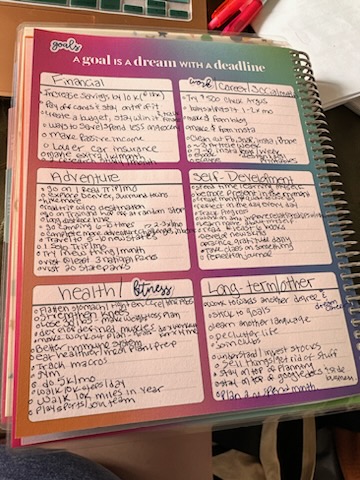
When planning it is important to set clear goals. Set goals for how you wanna plan and what you wanna accomplish. Break down your goals and set them in a straightforward, clear way so if you write them 6 months in advance you will still be able to follow them and know what you want to accomplish. When you have a project, whether it’ll take you a day, a week, a month, or a year, break down each one into clear goals and tasks in order to complete your project. Whether I am creating goals for the year, month, week or day or working on a project I also set goals and break my goals into more achievable and straight forward goals to ensure my project will get completed.
- Always Add Appointments As Soon As You Know
As soon as you know about an appointment or meeting, make note of it and add it to that planner of yours. I know sometimes I get appointments piled up and sometimes forget to add one in. I started to get into the habit of either always having my planner or making sure I write down the appointment as soon as I get home to make sure it gets added in. Writing it down as soon as you know about it helps you to not double book or miss something important. Definitely a highly recommended.
- Schedule Time To Rest Between Obligations
Make sure you schedule a break and time to rest. Making sure you get enough rest time is essential. If you don’t take a break you will get overwhelmed and burnt out and your later tasks might not get completed. Make sure you schedule in a break into your day to make sure you actually take a little rest like you deserve. This should be enough time to regroup and get some energy but not long enough to get unmotivated to finish the rest of your day. Scheduling time to rest is important for our mental, physical, and psychological well being.
- Set Reminders And Alarms
Set reminders for yourself. Set reminders everyday for every take. Set a reminder for deadlines. Create a deadline and set a reminder the day before, a few days before, a week before, etc (depending on the task). I am always so much more on top of my assignments when I set reminders for myself. Alarms and reminders are essential for staying on track and giving yourself time limits for breaks and tasks without going over because you lost track of time.
- Work With Color Coding
Color coding can be very beneficial. I use color coding to identify the different categories my tasks and appointments fall into. This helps me stay on track so I know how much I have going on and what I need to do in the different aspects of my life. For example, I have color coding for things for work, my social life, errands, chores, appointments, social media, this blog, and others. I keep track of all the different parts and categories in my life through color coding. You don’t have to go as in-depth as I do, but colors can also make your planner look fun and not so boring and bland as only using black or blue.
- Create An Idea “Drop Off” Space
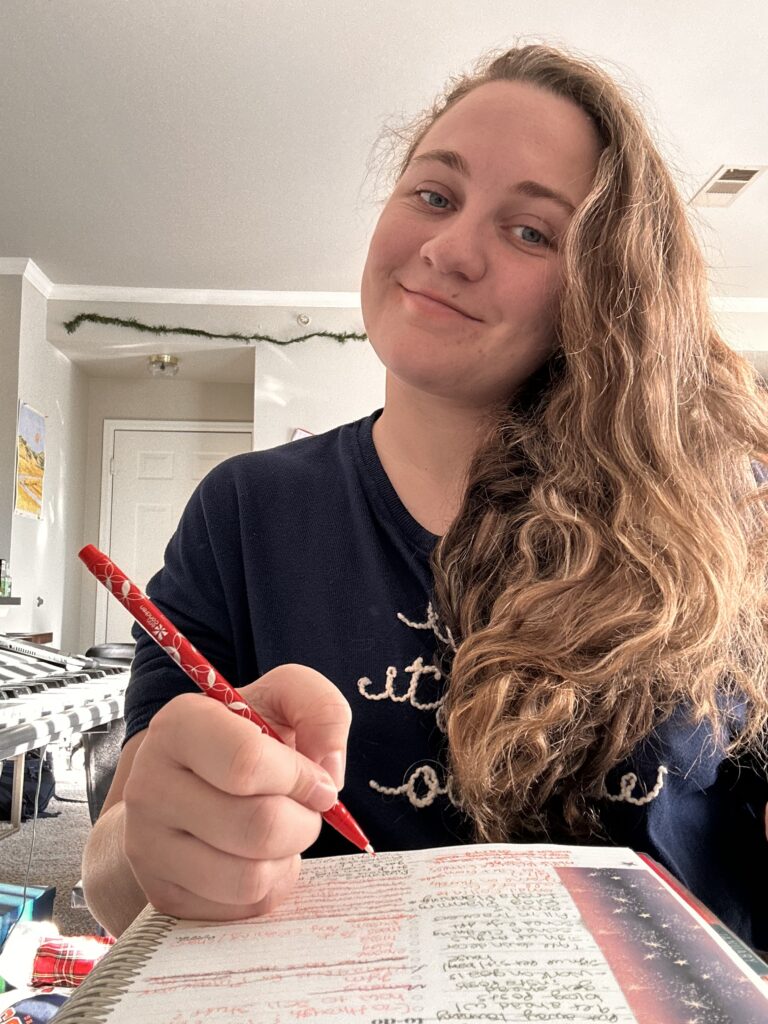
This space can be a whole separate notebook, it can be a few pages at the beginning or end of your planner, or a few pages you added to each month or week section of your planner. Having an idea drop off section could be very beneficial. This could be a section on adding ideas for how you want your year, month, week, or day to go. Ideas for different planning techniques, ideas for how to plan out your projects, or just creative ideas and projects you want to eventually plan and work into your schedule. Having a notes and idea drop off section can be extremely beneficial and make your planning run smoother and more efficiently.
- Ask For Help If Needed
Sometimes a lot comes up in our day and we start to get overwhelmed because we now have to find a way to fit in 5 more hours of work into our schedule that may have only had 30 free minutes in it. But never forget, it’s okay to ask for help. It’s okay to see if someone can help you complete something or help you by taking on one of your chores or assignments at work. We can’t always be expected to be superhuman. You’ll never know how willing people are to help unless you ask. The worst thing you can do for yourself is let your schedule and yourself get overwhelmed and overbooked. You’ll wear yourself out and you’ll end up needing a lot more help.
- Reward Yourself
You should always make sure you reward yourself. Plan a night or day to go out and reward yourself for staying on track of your assignments and completing big tasks or getting A on your paper or assignments. Plan a coffee date with yourself or go out for lunch today to the cafe or diner down the street you always been meaning to try. Reward yourself with saving money for something cool or getting yourself a small treat. It is important to reward yourself. It helps keep you on track and helps make completing everything on your to do list that much better. Even if your reward is something as small as a bath or going to bed early or getting into that ice cream you have in your freezer or giving in to having another cup of coffee. You can even reward yourself with something as small as a break or going to the park. It doesn’t have to be anything huge, you can even play a game. Taking time to reward yourself for staying on top of your to do list and your projects can help minimize procrastinations.
- Add Post Its For Important Reminders
For projects that are ongoing or for things you have to make sure you don’t miss or don’t forget try adding some post it notes to the calendar or on the days (if you have a daily planner) with the things you have to make sure you remember to do.
- Theme Days By Energy Level
If you know you have more energy on certain days of the week, plan to do your bigger, more time and energy consuming tasks on those days. If you have days you know you often feel burnt out, for example at the end of the work week, schedule the easier more mindless tasks on those days. This can make sure you have enough energy to complete your tasks to ensure they are getting done to their fullest potential and you are not overworking yourself by forcing yourself to complete the biggest projects on the day you feel the most worn out.
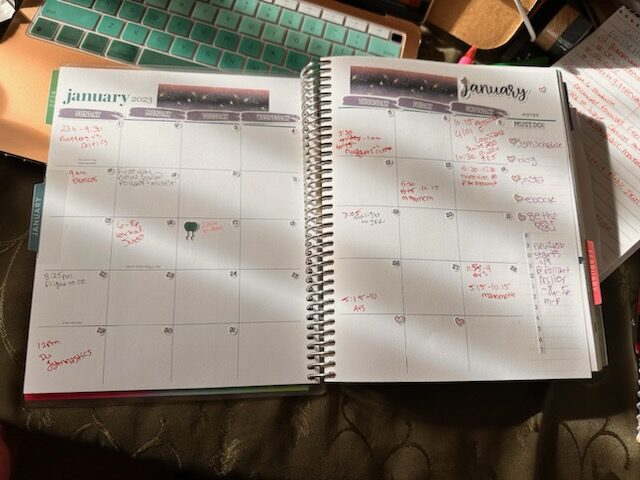
- Stay On Top Of To-Dos
Staying on top of your to-do’s is so important. I absolutely hate when I fall behind on my to-do lists. All of them throughout the whole week just keep on piling up and I try to rewrite them and then a 5 item list turns to a 20 item list because I didn’t stay on top of my things and tasks from all week piled up. Staying on top of your to-do’s. And also help keep you organized and ensure you are completing things in a timely manner. Staying on top can also help things not pile up and have you mess up your entire week because you end up forcing yourself to have a busier rest day at the end of the week because things didn’t end up getting done on the days you assigned those tasks to.
- Batch Similar Tasks Together
Batching similar tasks can mean batching them by the category they fall into or their level of how much time they consume or energy they need. You can batch them in whatever ways you want to. Batching similar tasks can help you get more done in a shorter amount of time. For example, if you need to do the dishes, clean your oven, and mop the kitchen floor, batching these together on the same day in the same time area can make all three tasks get done in under an hour instead of each one taking 30 minutes to an hour to complete. Or it can also make the overall bigger project seem to get done quicker and more efficiently.
- Plan For Week Ahead
At the beginning or end of the week, whichever works for you and whatever days your weekend falls on, start your planning. Create a list of everything you want or need to get done during the week and start to break down tasks or assign tasks to certain days. Looking at the entire week ahead can help you know what you might have to spend time preparing for and what days you’ll have to look forward to or what days you might need an extra cup of coffee to get through. Plan for the week ahead and fill out your planner and make sure you have all your appointments and everything you could have missed. Planning for the week ahead can help with less planning later on and can also help with a much more productive week.
- Carve Out Selfcare Time
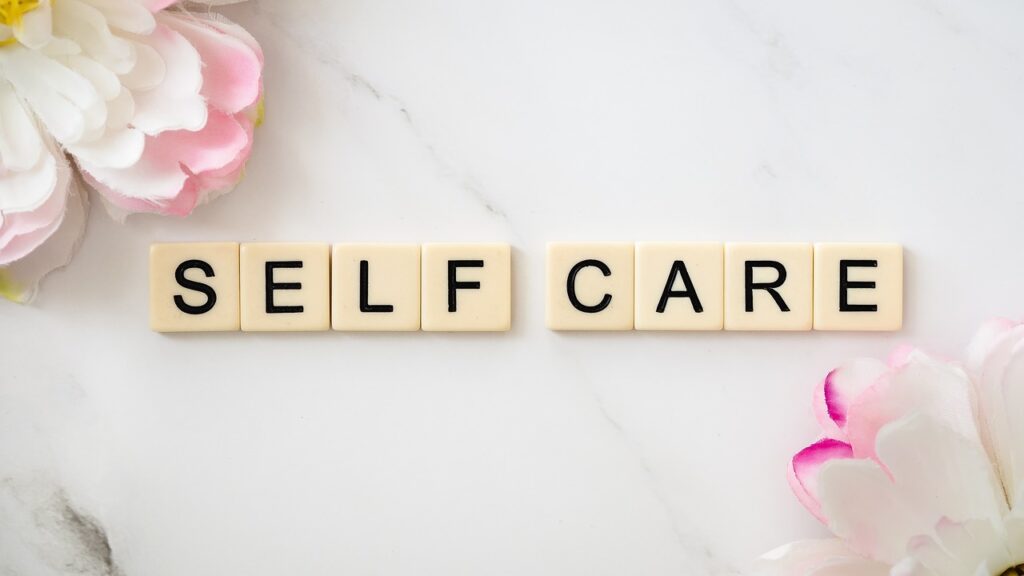
Carve out time every day for some Self care time. Carve out time in your planner to make sure you are taking care of yourself. Adding time into your busy day for self care can help make you feel refreshed and renewed. This can help give you the break and energy you need to push through your day or even your week. Carve out even just 5 minutes of your day to take time for yourself. You can sit outside, take a bath, go to the gym or go for a swim, spend some time with a friend, do a face mask, have a spa night, read a book, have a cup of coffee or tea, or even create an even more relaxing set up in your room. Do something to relax and take care of you. Schedule something once a week. It’ll help keep you feeling refreshed and ready to tackle anything and everything.
- Identify Top 3 For Laser Focus
When creating your schedule and when you go back and re-evaluate your schedule, identify your top three tasks. These can be your biggest three or your most important 3. Identify these three and laser focus on them to ensure those are the three you make sure you put your most focus on.
- Get Something Off Your Plate
When looking at your schedule, see if there’s anything you can get off your plate. Only if you’re super busy and you want to of course. Getting something off your plate can either mean assigning it to someone else or getting it off your schedule and assigning it to yourself at a later point in time. If you have tasks that aren’t as important and can be done at a later point in time, those are the easiest to reassign to yourself later on.
- Visualize How You Want It To Go
Take time and visualize how you want your day to go. Visualize how you want your week to go. Visualize how you want your project to go. Visualize how you want life to go. If you take time and map out and visualize how you want it to go, it can help you plan ways to break down tasks and create new ways of tackling them and completing everything you need to complete. Visualizing something can help your mind be more creative and help you come up with a better idea on how to get everything done.
- Follow A Set Morning And Evening Routines
Following a set morning and evening routine can help structure your day. A lot of what fills your day can vary and different stressors can arise and your tasks and projects can vary from day to day. However, starting and ending your day with similar routines can help to reset your mood so every day you can feel at ease and not be as overwhelmed. Having routines can help you be more structured in how you plan and focus throughout the day and can even help you become a more effective worker.
- Start Fresh When You Get Off Track
When getting off track, start fresh. Regroup. Refresh. Start your task over or go back to the beginning of the section and review what you have already done. Stopping to review can help refocus your mind to the beginning of where you were and help get your creative juices flowing to be able to continue. This has always helped me, especially with writer’s block. I just stop and reread what I have already written and try to come up with ways to continue. This can also help with planning. If you are breaking down a task and get stuck, restart. Reread the task and how you’ve already broken it down and try to branch out from there.
- Schedule Values And Priorities First
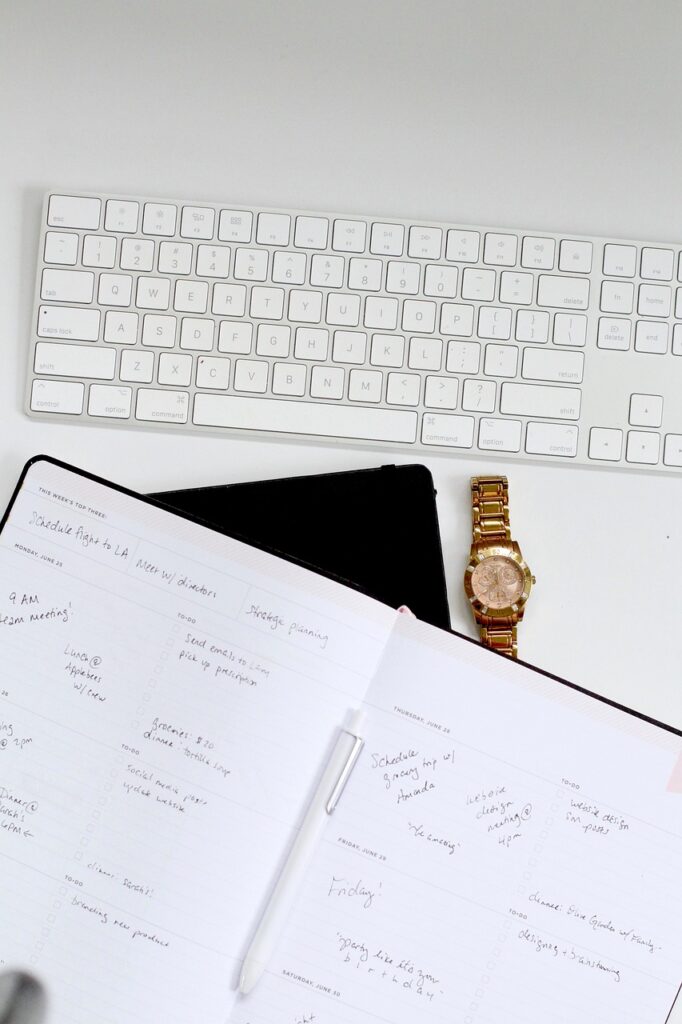
If you know what your priorities are and what items and things you value the most, schedule them first. Schedule them first because they are important to you and because they have an important deadline and you have to get them done. Schedule them and their to-do’s first and then schedule everything else that’s a little more flexible around it. This will help make sure it gets done and help avoid you running into an issue of not having enough time to get it done or fit it into your schedule.
- Adjust When Needed
Always be willing and able to adjust your schedule. You will have to move around and adjust things to be able to make sure everything gets done. Let’s be honest, things come up and people need to change the time of things, so you have to be able to adjust your schedule for not only yourself , but also for others.
- Work Backwards To Prep For The Day
When you go to plan your day, work backwards. Look at what you have to prepare for at the end of the day to help make the beginning of your day easier. If you work backwards, then you can make sure you aren’t forgetting anything and you aren’t missing anything. Looking at the end of the day can help you to make sure you don’t forget anything at home on your way to work for something you have to do afterwards. This can also mean that you are looking at the things you have to do first, last. Which will make them fresher in your mind and the last things you review so they are the first things on your mind to start. This can also help you to know if you have to rearrange anything at all to make sure everything gets done in case something runs late.
- Get Started With Small Stuff To Gain Momentum
At the beginning of your day, if you have the ability, plan some smaller things, or plan some smaller tasks to complete a bigger project first. This can help you gain momentum and gain motivation and energy to work up to the bigger tasks and the things that will take more time and energy to work on. Also, by starting smaller, you will get a lot more done in the first hour or two of your day and you will begin to feel amazing and be able to look back and see you crossed off a third of your to do list instead of starting big and seeing you haven’t even crossed off one thing in your first three hours. This will help you have a smoother morning and a smoother road into a very successful day.
- Touch Planner Before Touch Phone
Every day, touch your planner before you pick up your phone, I mean unless your phone is your alarm, then turn off that alarm first. Everyday, look at your planner and start your day. Start that first task or first time block, even if it’s a work out or simply having coffee or making your bed. Review your day and make sure you have everything ready and prepared for what you need. Make sure you have everything ready for work to be able to complete what you have going on and make sure you have anything ready you might need for the entire day. This can be making sure you have an outfit packed in your car for dinner or the gym or a hike or even bowling for right after work to change into. Touch your planner first so you can mentally prepare for your day before it begins.
- Review What Matters Most
Identify what matters the most to you and your schedule. Identify and review it. Review it to make sure it’s correct on its dates, correct on its timelines, correct on what needs to be done to complete it, and correct on that everything that matters the most to you has a time and place in your day and your schedule.
- Take Breaks

Breaks. Breaks. Breaks. Never be afraid to take a break. Breaks are amazing. If you are getting tired, take a break. If you are feeling overwhelmed, take a break. If you start getting a headache, take a break. And if you realize you’ve been working for 3 hours on the same paper and have gotten almost nowhere…… take a break.
- Change Mindset To Get Back On Track
If you ever find yourself procrastinating or getting off track a lot, take a break. Step away from your workspace or your tasks and regroup. Change your mindset. Do something to change the way you’re thinking and to refocus your mind. This will help you come back to work with a new mindset and a new ability to focus and jump back on track to a productive work day.
- Break Things Into 20 Minute Chunks
I love breaking things into time chunks. These can be 20 minute chunks or they can be 1 hour chunks. However, I find 20 minute chunks to be the easiest to work with. You can find any interval of about 20 minutes to be realistic for how long you want to focus on one task. I like time chunks because you can visualize and plan your day in time chunks. They help you stay on track and ensure you try to focus and devote enough time to various things.
- Do A Brain Dump
In a notebook, or the notes section of your planner, create a brain dump. Create a space to write down your thoughts and ideas. Write down random ideas you get for projects and ideas you get for planning. Ideas for events and activities. Create a brain dump of everything you need to get off your mind. It can help you find ways to get more done in less time. It can help clear your mind so you can regroup and focus on your day and tasks ahead. It can help you figure out how you are going to accomplish all of your tasks.
- Plan Your Day The Night Before
Every night take some time and relook at your day. Make final touches to your schedule for any last minute changes and updates you may get. Look at your to-do list again and re-evaluate it. Add what might have come up or change something you may have gotten to. Plan the night before so you know what you’re getting yourself into and what you have to attend to.
- Get Exercise
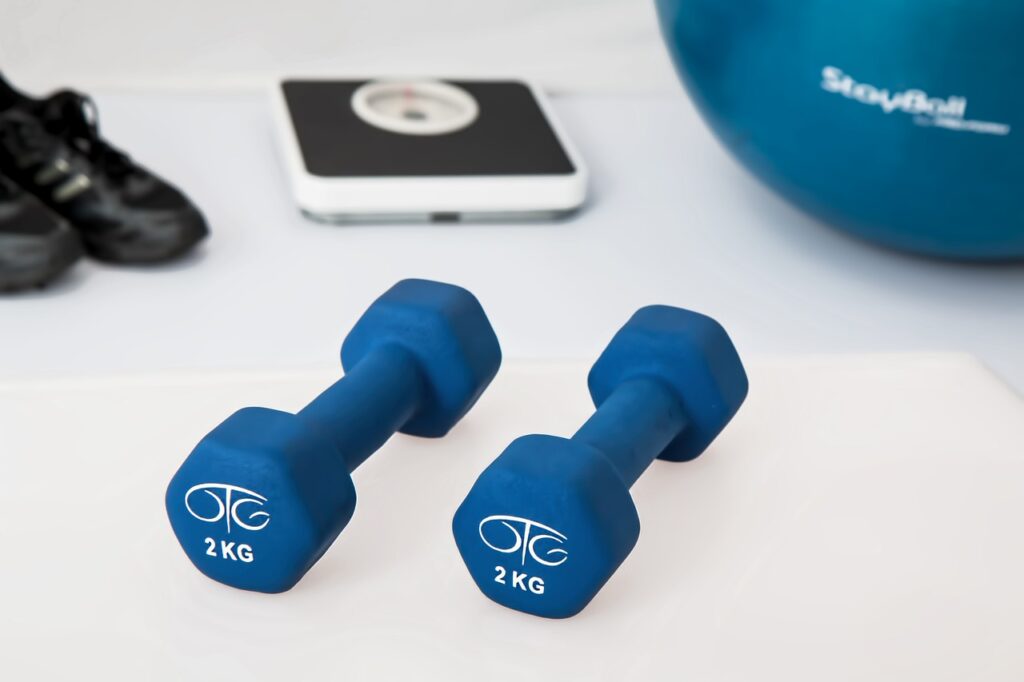
Getting exercise every day is important. Schedule exercise into your plan every day is essential. Regardless of if it’s 5-10 minutes or an hour plus, any form of exercise can be great for your focus and your mental health. Incorporating exercise can help keep your mind focused on the tasks it needs to get done. Planning exercise can help you get energized and ready to tackle all of your big and smaller projects. Lift some weights, walk outside, or try a 10 minute yoga video. Exercise your body to exercise your mind.
- Focus Daily Schedule And To-Do Lists
Create a daily schedule and daily to-do lists. Focus on these and help them guide you to a more productive life. Set aside time in your daily schedule for the things you know you do every day. For example, checking emails, taking care of yourself, doing your dishes, etc. focusing your day on your to-do lists can help you focus on things you need to accomplish today and every day. Let your schedules and lists guide and shape your day.
- Set Boundaries In Planner
Set boundaries for yourself and set them in your planner. Whether these boundaries are work related, task related or personal well-being related. Setting boundaries can be as simple as telling yourself to not take longer than a 20 minute break or telling yourself to not force yourself to work on a work project for longer than 3 hours. Boundaries can help keep the flow of everything.
- Use Labels And Stickers
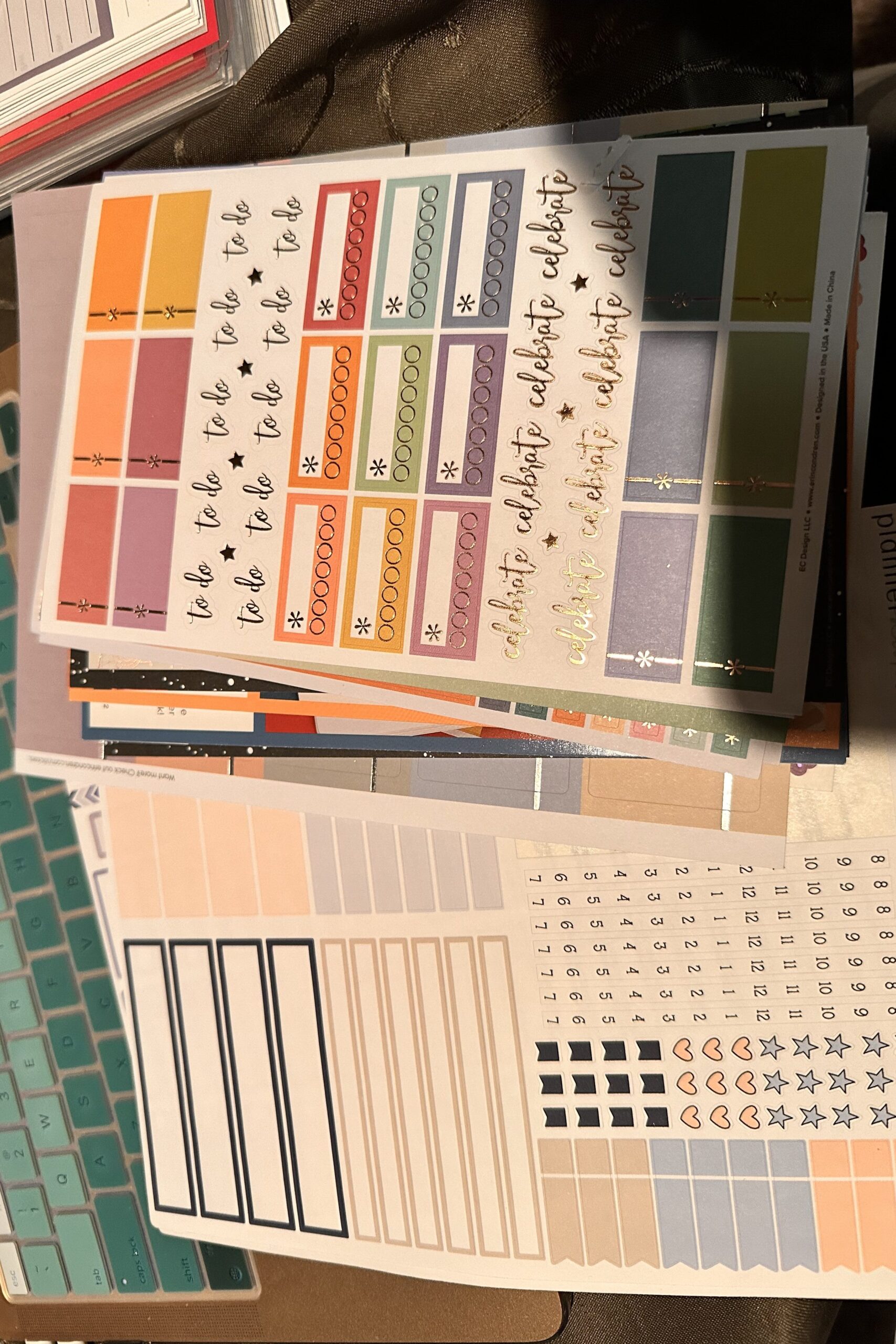
This is one thing I wish I could get more into. I have friends who when they plan they use so many labels and stickers. This can be a sticker of anything and you can create a code chart to identify what it means. Not only can stickers let you label over something already labeled, you might want it to say something different. It can help give you info about what happens on that day whether a bill is due, it’s pay day or someone’s birthday. Stickers can also look nice and be a good way of decorating your planner to a whole new level. Use stickers to help out you and your planner.
- Make Symbol Chart For Reference
If you’re going to be using symbols frequently throughout your planner, make a chart of all of them. Put the chart in either the front or back of your planner, or you can rewrite it on every month’s page if you want to. Leave room on the chart in case other symbols come up. It’s always good to be able to go back and reference it so you can continue to use these charts and you can go back and refer to it in case you forgot what you meant by a symbol. Keeping a chart can help keep you and your planner more organized.
- Be More Specific - MOTIVATION
It is always important to be specific with your goals. Be specific with your tasks, your projects, your assignments and your motivation to complete everything. The more specific you are the easier it is to know where your motivation lies. Being specific on your motivation can help remind you when you want to accomplish what you want to accomplish. If you need to write out in your notes page or your notebook your motivation. Write out a motivational quote or two. This will help you know why you start and why you’re going where you’re going. This can help you jump back on track and know why you’re on this track.
- Change Contacts To Date Night Ideas - OR Places To Go Or Goals
If you are someone who doesn’t need the contacts page in your planner, try changing it to something else. You can change it to date night ideas and add the phone number of the place and where it is and a potential date you want to do it and any other information, such as if you need to make a reservation or book tickets online and how much it might cost. You can also change it to places you want to go or goals you want to achieve. Depending on how your contacts page is laid out can help decide how you’ll add whatever you will change it to.

- Tape Page With Info Always Referencing In The Back - Ex. Color Code, Abbreviations, Symbols
Having a key or a reference is very important. I always make a key for at least my color code. I’ll either write it on a blank page in the front or the back. However, taping it and folding it in is also a very beneficial way. This way you can just unfold it and bam, there’s all of the information you need. Having it in the very back is the best so you don’t have to rewrite it or flip through your planner to try to find the page. Take either the last page in your planner if you have a note section or get a blank piece of paper and tape it in and fold it over. On this piece of paper, add your color coding, add any symbols you might use such as $ for bill due, add any abbreviations you might use, for example, PYD or PD for pay day or MTG for meeting or any other things you might come up with that you want to use to help make your planning the easiest possible.
- Do Research To Make Sure You Have The Perfect Planner For Your Needs
Having a bad planner cannot only affect you but it can alter your ability to set you up for success. Figure out what you need and want a planner for and do your tea search. Maybe join a planner group on Facebook or ask some of your friends. Ask some bloggers and influencers on Instagram. This way you can get an idea of what different people use and what works for them and why. If you’re a simple planner and you just need the days of the month to write appointments, maybe a monthly planner might be the best. Just enough space to write in the boxes of the month. I personally use and love Erin Condren planners, ever since my friend got me hooked. However, if my needs change, a new planner might work best for what I need.
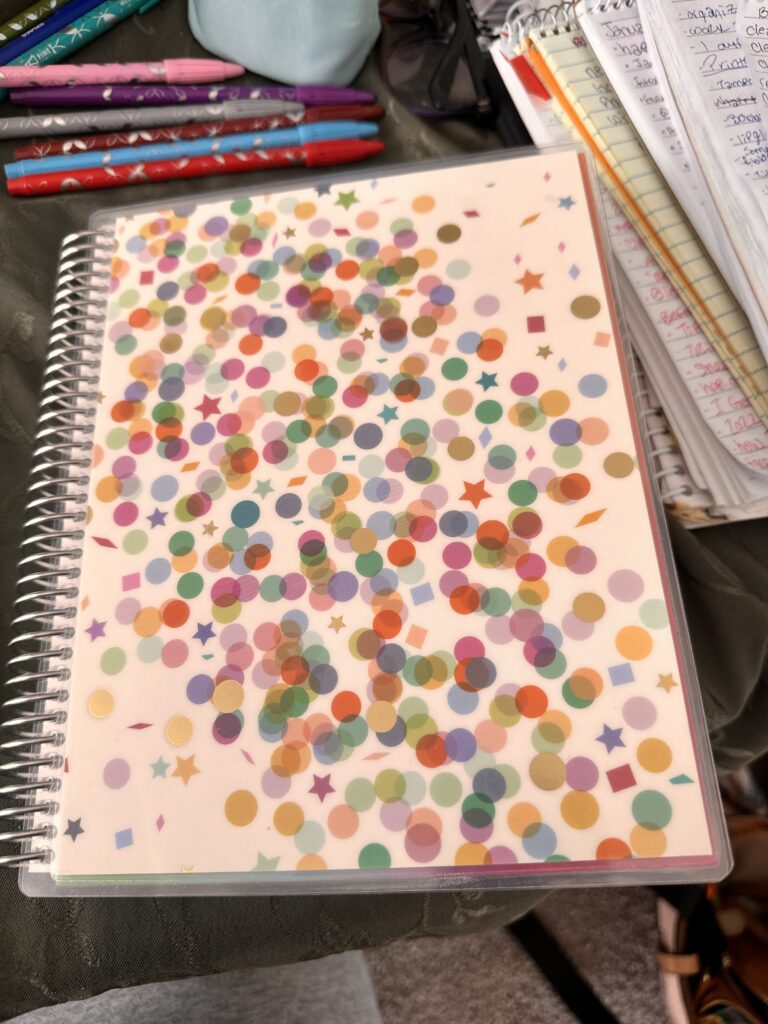
There are countless hacks and tips and tricks to planning. Countless things that may work for me or people I know but might not work for you. Planning is sometimes unique to a person because it has to depend on what you have going on in your life, the things you work on, how many people in your life you have to account for, and so many other things.
So, these are just a few suggestive hacks. I hope at least one or two help.
57 Planning tips and hacks
- Devote time to planning everyday
- Make a list of larger projects that you need to break down into more manageable tasks/lists
- Identify problems in your day early
- Use time blocks
- Be realistic
- Allow for unforeseen challenges – what will you do if xyz occurs
- Prioritize tasks
- Multitask when appropriate
- Tackle most dreaded task(s) first
- Start day before everyone else gets up
- Schedule pockets of calm in your day
- Leave a margin in every day
- Know when to delegate
- Re-examine/evaluate regularly
- Find a system that works for you
- Accept limitations
- Plan with a purpose
- Use tool to organize life
- Set clear goals
- Always add appointments as soon as you know
- Schedule time to rest between obligations
- Set reminders and alarms
- Work w/ color coding
- Create an idea “drop off” space
- Ask help if needed
- Reward self
- Add post its for important reminders
- Theme days by energy level
- Stay on top of to-dos
- Batch similar tasks together
- Plan for week ahead
- Carve out selfcare time
- Identify top 3 for laser focus
- Get something off your plate
- Visualize how you want it to go
- Follow set morning and evening routines
- Start fresh when get off track
- Schedule values and priorities first
- Adjust when needed
- Work backwards to prep for day
- Get started with small stuff to gain momentum
- Touch planner before touch phone
- Review what matters most
- Take breaks
- Change mindset to get back on track
- Break things into 20 min chunks
- Do a brain dump
- Plan day the night before
- Get exercise
- Focus daily schedule and to-do lists
- Set boundaries in planner
- Use labels and stickers
- Make symbol chart for reference
- Be more specific – motivation
- Change contacts to date night ideas – or places to go or goals
- Tape page with info always referencing in the back – ex. Color code, abbreviations, symbols
- Do research to make sure you have the perfect planner for your needs